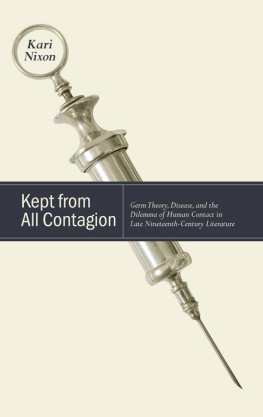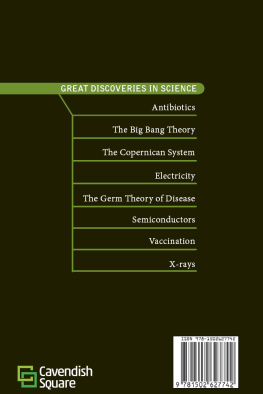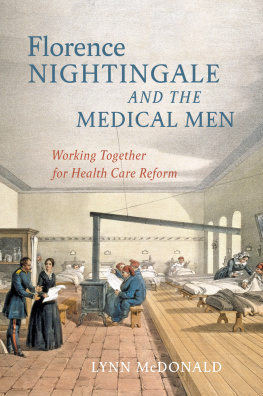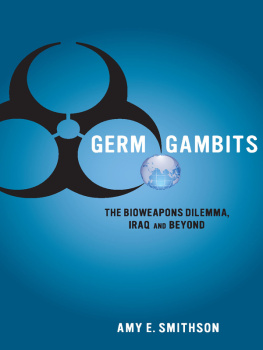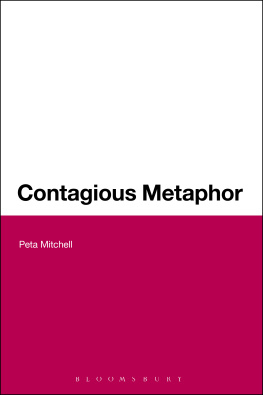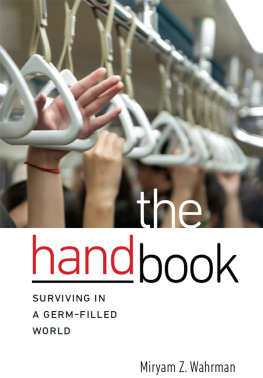Kept from All Contagion
SUNY series, Studies in the Long Nineteenth Century
Pamela K. Gilbert, editor
Kept from All Contagion
Germ Theory, Disease, and the Dilemma of Human Contact in Late-Nineteenth-Century Literature
Kari Nixon
Published by State University of New York Press, Albany
2020 State University of New York
All rights reserved
Printed in the United States of America
No part of this book may be used or reproduced in any manner whatsoever without written permission. No part of this book may be stored in a retrieval system or transmitted in any form or by any means including electronic, electrostatic, magnetic tape, mechanical, photocopying, recording, or otherwise without the prior permission in writing of the publisher.
For information, contact State University of New York Press, Albany, NY
www.sunypress.edu
Library of Congress Cataloging-in-Publication Data
Names: Nixon, Kari, author.
Title: Kept from all contagion : germ theory, disease, and the dilemma of human contact in late nineteenth-century literature / Kari Nixon.
Description: Albany : State University of New York Press, [2020] | Series: SUNY series, studies in the long nineteenth century | Includes bibliographical references and index.
Identifiers: LCCN 2019027881 | ISBN 9781438478494 (hardcover : alk. paper) | ISBN 9781438478500 (ebook)
Subjects: LCSH: Communicable diseases in literature. | Germ theory of diseaseHistory19th century. | Literature and medicineHistory19th century. | Medicine in literature. | Literature, Modern19th century.
Classification: LCC PN56.D56 N59 2020 | DDC 809/.933561dc23
LC record available at https://lccn.loc.gov/2019027881
10 9 8 7 6 5 4 3 2 1
Contents
INTRODUCTION
The Germ Theory Again: Disease, Ideology, and the Possibilities of Biotic Life in the World of Antibiotic Purity
CHAPTER 1
Keep Bleeding: Plague, Vaccination Debates, and the Necessity of Leaky Boundaries in Defoes Journal of the Plague Year and Shelleys The Last Man
CHAPTER 2
A Speculative Idea: Childbed Fever, Early Germ Theory Debates, and (En)gendered Speculation in Henry Jamess Washington Square
CHAPTER 3
Separation and Suffocation: Tuberculosis, Etiological Uncertainty, and Female Friendship in Womens Fiction
CHAPTER 4
Tainted Love: Venereal Disease, Morality, and the Contagious Disease Acts in Ibsens Ghosts and Hardys The Woodlanders and Jude the Obscure
CHAPTER 5
Humanitys Waste: Typhoid Fever, the Failure of Isolation, and the Development of Probiotics in Three Late-Century Works
CONCLUSION
Shuffling Within Our Mortal Coil
Illustrations
Acknowledgments
A version of was published in Journal for Medical Humanities online in 2014 and in print in 2017.
Thank you to the Wellcome Librarys online and physical holdings, and for their permission to use several images included in this book. I thank also Scholastic, for their generous permission to reprint a page from their magazine in this book.
I would like to acknowledge the support of SUNY Press as I went through the publication process, as well as Pamela Gilbert, the series editor. I am also grateful to the Sons of Norway for funding my research trips to Oslo to work on parts of this project, as well as the later funding of Whitworth University, which allowed my final trip to England in finishing this project.
I am forever grateful to the intellectual inspiration and guidance of my mentors, Ross Murfin, Beth Newman, and Rajani Sudan, who undertook the cultivation of a confused psych-school dropout and taught her the wonders of literary analysis and the medical humanities. I dont know that there will ever be words to fully express the impact youve had on my life in its deepest, intellectual understandings of the worldand because you all know me, you know that this speechlessness itself is rare. My loss for words of expression here is in fact the best indicator I can give of your profound influence on this heart which beats / so wild, so deep in usto know / whence our lives come and where they go.
No (hu)man is an island, as I will argue for the next several hundred pages, and I am no exception. The near-decade spent in penning this book also covered a decade of marriage, in which my unfailingly loving partner Daniel brainstormed ideas with me, read books alongside me, read over my chapters, waited outside of London museums while I conducted research, and stayed at home with an infant and a toddler while I went off to work to contemplate the past. Our late-night chats about my ideas, in which he traveled with me conceptually, have always been integral to my work. This book wouldnt exist without him.
To Betty and Mike: your support has always been more integral than youll know. You never questioned my journey, and youve always been my cheerleaders.
For teaching me that were all better off if we care about those around useven when we might not be obligated toI thank my parents, Anne and Kevin. The lessons about life and responsibility you taught me were undoubtedly foundational to the way I look at the world, history, and Victorian culture. Thank you also to my sister, Gracie, for teaching me the beauty of fearless love.
To Florence-Estelle (Flora) and Zelda-Elizabeth (Libby), I have only to quote Dickens:
You have been in every line I have ever read. You have been in every prospect I have ever seen sinceon the river, on the sails of the ships, on the marshes, in the clouds, in the light, in the darkness, in the wind, in the woods, in the sea, in the streets. You have been the embodiment of every graceful fancy that my mind has ever become acquainted with. The stones of which the strongest London buildings are made, are not more real, or more impossible to be displaced by your hands, than your presence and influence have been to me, there and everywhere, and will be.
Your wondrous verve has taught me the revivifying value of human connection more than anything, at any price.
Introduction
The Germ Theory Again:
Disease, Ideology, and the Possibilities of Biotic Life in the World of Antibiotic Purity
Disease in the Community and the Self-at-Risk
In 1877, Chamberss magazine published an article wryly titled The Germ Theory Again. The tonal dissonance between these two publications highlights a key moment in history, in which I locate the goals of this project: the period between 1870 and 1900 when germ theory had gone viral, so to speaksaturating media discourse and reaching a wide audience of popular science readers who engaged with and understood the concepts it embodiedand yet simultaneously remaining mystifying and rather terrifying to the audience that consumed knowledge of it so readily.
The growth, popularization, and prevalence of germ theory resituated the focus of scientific discourse on the humble microbe, and this conceptual priority in turn gave rise to the field of bacteriology at the end of the century. In a society just a decade beyond Darwins famous publications, This terror of small things must be seen, of course, as not merely a new and unexplored fear of the unseen, but a fear of a ubiquitous and omnipresent unseen. By the 1870s, nineteenth-century scientific cosmologies saw microbial life not as a series of invisible, separate particles, but an inescapable mass of potential contagiona mist as this author calls itthat terrifyingly linked society together in a messy Petri dish of humanity, unheedful of social, class, gender, and sexual boundaries.

